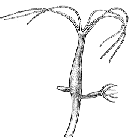
| About | | Search taxa | | Taxon tree | | Search literature | | Checklist | | Stats | | Log in |
WoRMS taxon detailsHydridae Dana, 1846
recent only
Dana, J.D. (1846). Structure and classification of zoophytes. <em>Lea & Blanchard, Philadelphia.</em> pp. 132., available online at https://www.biodiversitylibrary.org/page/11711738
page(s): 116 [details]
Schuchert, P.; Choong, H.; Galea, H.; Hoeksema, B.; Lindsay, D.; Manko, M.; Pica, D. (2025). World Hydrozoa Database. Hydridae Dana, 1846. Accessed through: World Register of Marine Species at: https://www.marinespecies.org/aphia.php?p=taxdetails&id=151708 on 2025-07-15
Date action by
Nomenclatureoriginal description
Dana, J.D. (1846). Structure and classification of zoophytes. <em>Lea & Blanchard, Philadelphia.</em> pp. 132., available online at https://www.biodiversitylibrary.org/page/11711738 page(s): 116 [details] basis of record Howson, C.M. & B.E. Picton. (1997). The species directory of the marine fauna and flora of the British Isles and surrounding seas. <em>Ulster Museum Publication, 276. The Ulster Museum: Belfast, UK. ISBN 0-948150-06-8.</em> vi, 508 (+ cd-rom) pp. (look up in IMIS) [details] Available for editors Taxonomyredescription
Holstein, T. 1995. Cnidaria: Hydrozoa. pp. 1-142. In Süsswasserfauna von Mitteleuropa Gustav Fischer Verlag, Stuttgart [details] Othercontext source (MSBIAS)
MEDIN. (2011). UK checklist of marine species derived from the applications Marine Recorder and UNICORN. version 1.0. [details]
additional source Bouillon, J.; Gravili, C.; Pagès, F.; Gili, J.-M.; Boero, F. (2006). An introduction to Hydrozoa. Mémoires du Muséum national d'Histoire naturelle, 194. Muséum national d'Histoire naturelle: Paris, France. ISBN 2-85653-580-1. 591 + 1 cd-rom pp. (look up in IMIS) [details] additional source Schuchert, P. (2010). The European athecate hydroids and their medusae (Hydrozoa, Cnidaria): Capitata Part 2. <em>Revue Suisse de Zoologie.</em> 117: 337-555., available online at https://doi.org/10.5962/bhl.part.117793 page(s): 440 [details]  Present Present  Inaccurate Inaccurate  Introduced: alien Introduced: alien  Containing type locality Containing type locality
From editor or global species database
Diagnosis Hydroid solitary, with hollow filiform tentacles, but often moniliform distally, in one whorl under hypostome; lower part of hydranth with simple pedal disc, no perisarc except on encysted embryos.. Without medusa phase or gonophore development, eggs and sperm developed directly in epidermis of polyps in wart-like protuberances; asexual reproduction by lateral buds, leading only to temporary colonies [details]
|

